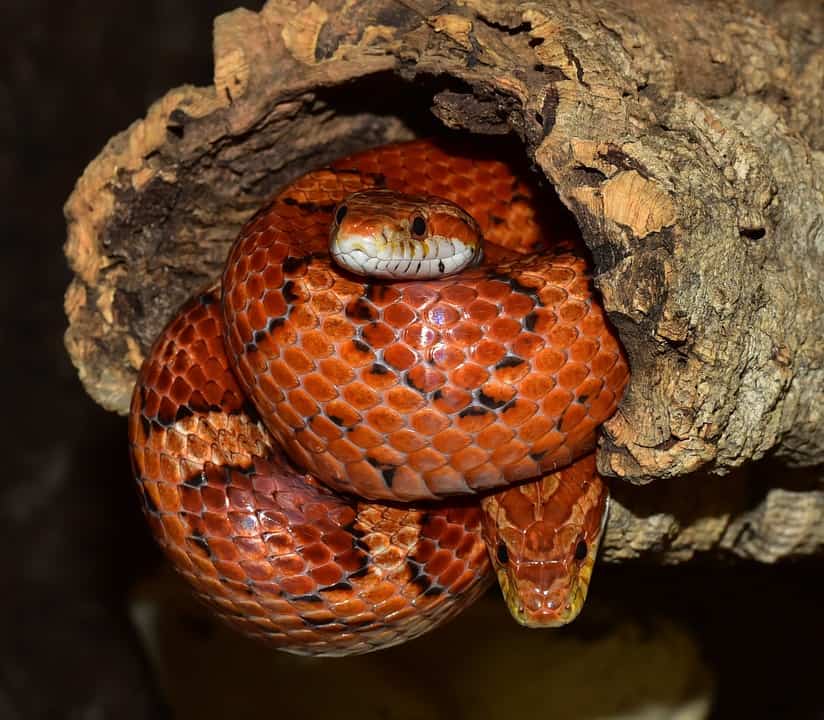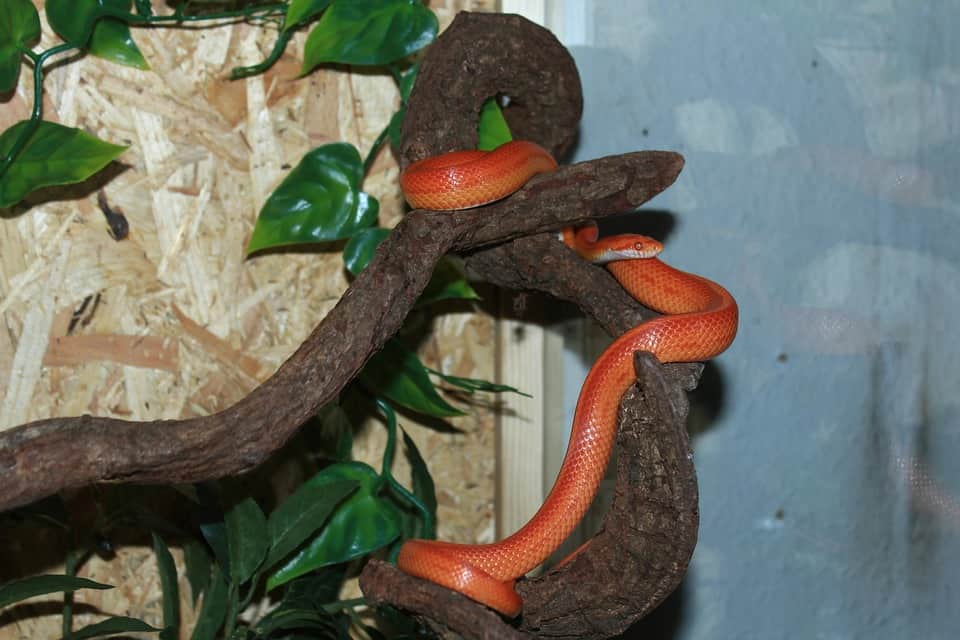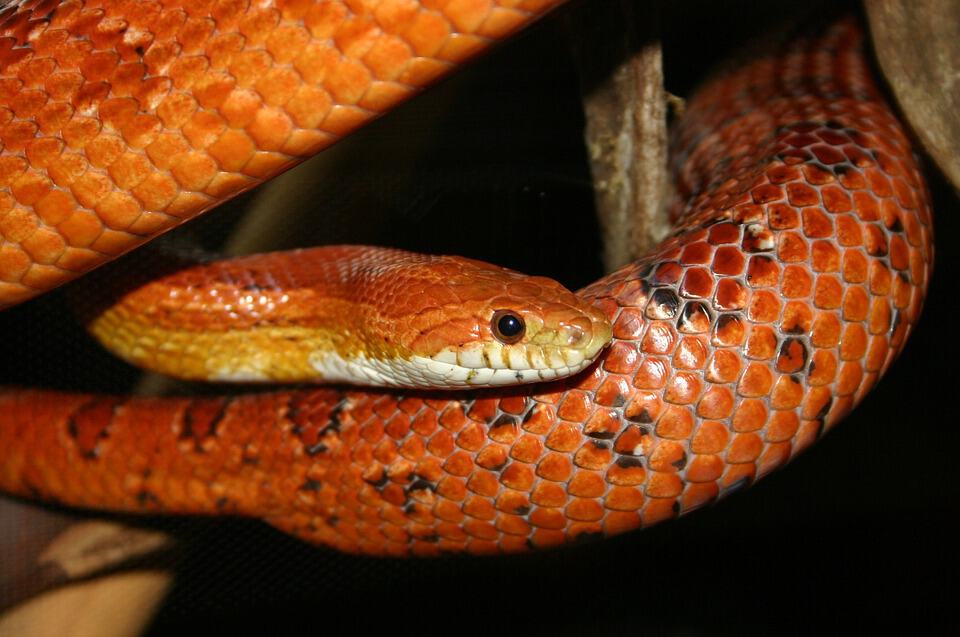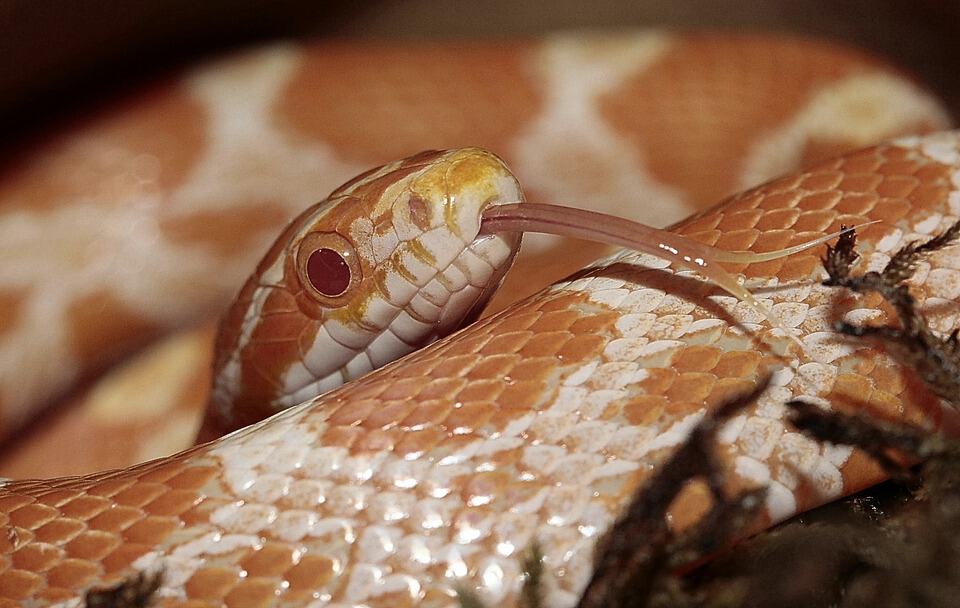Although I’ve always been slightly more partial to Indo-Australian pythons, I’ve maintained a handful of corn snakes over the years, primarily as ambassadors to the public that I’d use during live animal presentations.
Without exception, they’ve all made fantastic captives, and I enjoyed maintaining each and every one. They’re not only easy to care for. But they’re quite attractive, and they tolerate human interaction as well as any species I’ve had the chance to work with.
In fact, corn snakes are often considered one of the species that is best-suited for captivity. A notion with which I’d wholeheartedly agree. So, be sure to review the information presented below, to help determine if a corn snake is a good species for you.
Corn Snake Facts
Before learning about the husbandry of corn snakes and the type of care they require, you’ll need to familiarize yourself with the basics of the species:
- There is some dispute over the inspiration for the common name “corn snake.” Some contend that these snakes were named after the corn- or maize-like pattern on their ventral surfaces, while others believe it is because these snakes commonly inhabited cornfields, where they’d feed on the resident rodents and birds.
- Corn snakes may exhibit several different colors and patterns. Most wild corn snakes are relatively similar looking (although they vary geographically), however, pattern and color mutations are very common among captive bred individuals. This allows hobbyists to obtain corn snakes that display virtually every color of the rainbow.
- Corn snakes constrict their prey to subdue it. Just like pythons, boas and countless other species, corn snakes will wrap their body around prospective prey animals and squeeze them tightly, until the animal falls unconscious. Then, the snake will eat their prey without having to worry that it will escape or fight back.
- Corn snakes vibrate their tails when frightened. When confronted by a predator or threat, corn snakes vibrate their tails. When the tail contact leaf litter or other debris, it can create a buzzing sound reminiscent of a rattlesnake’s tail.
- Corn snakes may be active at any time of day or night. Corn snakes are flexible animals, who can change their behavioral patterns to suit their circumstances. They probably default to diurnal activity patterns. But when temperatures become too hot in the summer, they’ll shift to a crepuscular or nocturnal lifestyle.
- Corn snakes are very skilled climbers. Like most other rat snakes, corn snakes can climb trees well. Because they are good climbers, corn snakes often feed heavily on birds in the wild.
Lifespan: How Long Do Corn Snakes Live in Captivity?
Corn snakes are fairly long-lived reptiles. Like most other reptiles, wild corn snakes have a very high mortality rate during the first year or two of life, as they’re consumed by a variety of predators. However, many of those who reach adult size likely live for 10 years or more.
In captivity, corn snakes routinely reach the 20-year-mark when maintained by skilled and experienced keepers. And the oldest recorded individual lived for 32 years and 3 months.
Size & Weight: How Big Do Corn Snakes Get?
Corn snakes are medium-sized serpents. Typically, adults will reach lengths of 3 to 5 feet, depending on their geographic origin. However, the largest specimens will approach or slightly exceed 6 feet in length. Most adults will weigh between 1 and 3 pounds.
Teeth: Do Corn Snakes Bite?
Like most other snakes, corn snakes do have teeth. Like most other snakes, corn snake teeth are arranged in two semi-circular rows on the top and bottom jaw, and they also have two relatively straight rows of teeth on the roof of their mouth, inside the outer row.
Juvenile corn snakes are often a bit nippy. But they typically calm down over time and become quite docile as adults. There are, however, exceptions, and some corn snakes will remain willing to bite for their entire life.
Nevertheless, corn snake bites are rarely serious. They usually result in little more than a few barely visible pinpricks. If you are nervous about being bitten, you can simply wear some outdoor work gloves when handling your pet. They should provide sufficient protection from your snake’s teeth.
Health & Behavior: What Is Common and Unusual?
For the most part, corn snakes are fairly hardy serpents, who don’t exhibit many bizarre or unusual behaviors. We’ll talk about some of their basic behavioral and health traits below.
General Behavior
Like most other snakes, corn snakes are not particularly active. In fact, they’ll spend the vast majority of their time resting or sleeping (it is difficult to tell when a snake is sleeping versus resting, as they lack eyelids). Most commonly, they’ll spend their time coiled up in a hiding space. But they may also lounge on top of their climbing branches. Rarely, they may even lay out in the open.
From time to time, you’ll also see your snake exploring the habitat. This may occur during the day or night. Typically, corn snakes will become most active when they are hungry. But they may also become active during seasonal changes or before shed cycles.
Shedding
Like all other snakes, corn snakes will shed their skin periodically. This is associated with growth, but it also serves as a way for the snake to replace damaged scales or repair other wounds.
The entire shedding process typically takes about one week to complete, but there are exceptions. Some snakes will occasionally exhibit rather lengthy shed cycles, which can take up to two weeks to complete. The first thing you are likely to notice when your snake is entering a shed cycle is a generally dulling of his color.
A few days later, he will start to appear somewhat cloudy, and a few days after that, his eyes will turn bright blue (snakes are often said to be “in the blue” during this phase of the shed cycle). This occurs because your snake’s body will begin producing a lubricating fluid between the old, outer skin and the new, fresh skin beneath. This fluid also occurs between the outer and inner scales of your snake’s eyes (called the spectacles), which causes them to look blue.
A few days later, your snake’s eyes will clear up and he’ll look completely normal again. Then, a day or two later, he’ll typically shed his skin, starting the entire process anew.
Ideally, your snake should shed in one long, complete piece. But snakes who are sick, stressed, recovering from injury, or maintained in excessively dry conditions, will often shed in several smaller pieces. In some cases, your corn snake may even retain portions of his old skin. This is usually relatively easy to rectify by soaking your snake in a shallow (about 1-inch-deep) water for an hour or so, and then gently rubbing the affected area.
Eating Problems
Part of the appeal of corn snakes is their appetite and willingness to consume frozen-thawed rodents. Young (hatchling) corn snakes occasionally prefer rodents that have been scented with lizards, birds or frogs, but by the time they’re offered for sale, most corn snakes are readily eating unscented rodents.
However, snakes can refuse food for a variety of reasons. Sometimes they do so because they are entering a shed cycle, or they are undergoing seasonal dormancy (during the fall or winter). In some cases, they may refuse food because of their reproductive condition (gravid females often refuse food, as do males who are interested in finding mates). Additionally, illness and improper husbandry can also cause a snake to refuse to eat.
Generally speaking, you shouldn’t worry very much if your snake refuses one or two meals. It takes snakes a very long time to starve (months to years), and most will begin eating again once they shed, deposit eggs, or otherwise deal with the problem that was preventing them from eating.
However, if your snake does not eat for three to four weeks, it is wise to review your husbandry practices and contact your vet. Things like respiratory illnesses and parasites can cause a snake to refuse food, and you’ll want to address these issues promptly, to give your pet the best chance at a full recovery.
Signs of Illness
Although corn snakes are typically healthy serpents, they are susceptible to many illnesses. You can help your snake avoid many illnesses by simply maintaining the habitat properly, and your vet can often help you treat any illnesses that do occur. But it is imperative that you keep an eye out for any signs of trouble, so that you can address them promptly.
A few of the most important signs and symptoms of illness you must watch for include:
- Discharge from the nose or mouth, as this often indicates the presence of an upper respiratory infection. Respiratory infections can become quite serious for snakes, so prompt veterinary attention is crucial for your snake’s chances of survival.
- Vomiting or diarrhea can signal that your snake is battling a gastrointestinal infection or parasites. These types of problems require prompt attention to give your snake a chance at a full recovery. Also, note that many of these pathogens and parasites are contagious, which is a serious concern for those who maintain multiple snakes.
- Unusual soaking habits (such as lounging in the water dish for long periods of time) may signal that your pet is suffering from mites. Mites are very difficult parasites to eradicate, and they can infest an entire collection of snakes in a matter of days. Accordingly, keepers must always act quickly and decisively anytime they’re found.
- Pacing or resting with an open mouth can indicate that your snake is overheating. Snakes may become sick if kept in enclosures that are too cool, but they can quickly die if kept in enclosures that are too hot. Pacing, “panicked” behavior is one of the most reliable signs that a snake is too hot.
If you notice any of these symptoms, be sure to make any husbandry changes necessary and contact your veterinarian.
Habitat: The Ideal Corn Snake Enclosure
In most respects, corn snakes are easy to house. We talk about their housing requirements in greater depthhere, but we’ll discuss the basics below.
Glass aquaria are acceptable enclosures for corn snakes, provided that they are fitted with a screened top to provide ventilation. However, plastic enclosures designed specifically for reptile maintenance are generally the better option.
Plastic enclosures are not only lighter and more durable than glass aquaria. They typically feature front-opening doors which make maintenance easier.
Additionally, plastic enclosures are usually opaque on all but one side, which will help keep your pet comfortable and stress-free.
As a rule of thumb, your pet will need a habitat with a perimeter that is at least twice your snake’s length. In other words, a 3-foot-long corn snake requires a habitat with a 6-foot perimeter.
You’ll need to add a few things to the habitat to make it comfortable for your snake. This includes a safe substrate, a water dish, and at least one hiding box. Climbing branches aren’t necessary, but most corn snakes will use them.
It is also important to maintain appropriate temperatures and establish a thermal gradient (range of temperatures) in the habitat. This will require you to purchase and install a heating device of some type and a digital thermometer.
Heat pads, heat tape, and radiant heat panels are all options. But they’ll require you to purchase a thermostat, which will keep these devices at the appropriate temperature. Instead, you can also use a heat lamp, which doesn’t require a thermostat.
>Read more: Corn Snake Habitat: What Is the Ideal Tank Setup?
What Is the Corn Snake Diet?
Wild corn snakes hunt a variety of different species, but it is usually wise to provide captive corn snakes with a rodent-based diet. Unlike frogs and lizards, which may transmit parasites to your pet, commercially reared rodents are relatively unlikely to cause similar problems. Additionally, commercially reared rodents are readily available and pretty affordable too – particularly if you purchase them in bulk.
Hatchling corn snakes are obviously not large enough to handle a full-grown mouse. You’ll need to start your pet on neonatal mice (called “pinkies” or, once they develop a bit of hair, “fuzzies”). As your snake grows, you’ll be able to gradually increase the size of the rodents provided. Within 6 to 12 months, your snake should be able to consume adult mice. Most adults eventually grow large enough that you’ll need to feed them multiple mice or a single small rat on feeding days.
Corn snakes are perfectly capable of catching, subduing and killing live rodents. But – just as occurs in the wild – they may occasionally become injured in the process.
Accordingly, it is advisable to forego live rodents and instead feed your pet prekilled, frozen-thawed mice or rats. This is also a more humane practice for the rodents used to feed your pet.
We discuss feeding corn snakes in greater depthhere, so be sure to review that article before you bring home your new pet.
>Read more: What Do Corn Snakes Eat? A Diet & Food Guide
Price: How Much Do Corn Snakes Cost?
Corn snakes vary wildly in terms of price, based on their age, sex, appearance and genetic makeup.
Normal-looking babies can usually be found for less than $50, and they’re often less than half this price. Normal-looking adults can also be found for similar prices, particularly if you are willing to purchase a male (normal-looking females are typically more expensive than normal-looking males).
However, there are dozens of different color and pattern mutations available – including individuals who display several different mutations simultaneously. Some of these mutations are so common that they cost little more than normal-looking corn snakes. But others fetch hundreds of dollars. Those who exhibit particularly rare mutations or possess unique combinations of mutations may creep into four-digit-price-tag territory.
Corn Snakes as Pets: Are They Good Pets?
As you can see, corn snakes possess a number of traits that make them very attractive to reptile-keeping enthusiasts. They are generally docile and inoffensive. Also, they are hardy and easy to maintain. And, they reach almost ideal sizes in the minds of most keepers. Additionally, they come in an array of colors and patterns to suit keepers with different aesthetic tastes.
All of these things combine to ensure that corn snakes are not only good pets. But they may very well be the very best pet snake species available – particularly for novices.













21 Comments
Hi Ben, thanks for the useful article. I’ve just inherited two corn snakes from an emigrating relative. Not my usual pet!
Each has its own tank, about 3ft 3 inches long, a foot wide, and about a foot and a half high. The snake itself is just about the length of the tank itself. When you say the perimeter must be twice the snake’s length, does that mean this tank size is still acceptable?
I worry that these tanks are too small! I would hate to have a subpar environment for the little guys. Would it be a good call to have a larger tank made?
Also – I believe that up until recently, these two snakes shared a tank. Now each has their own. But I could also just join the tanks and effectively double their space. But then they share. Is that an option, or rather not? Pardon my ignorance, I’m still researching this whole thing!
I REEEEAAAAAALLLLYYYYY want a pet corn snake. how do I get my dad to let me? I know all about them!
Hi Clara,
It sounds like you’re enthusiastic and knowledgeable, which is a perfect start. To convince your dad, I’d suggest focusing on a few things. First, show him you are responsible by taking good care of yourself and your chores. Also, create a clear presentation about corn snake care, including costs, feeding, and housing – you can find excellent resources right here on our website. Lastly, talk to him calmly and respectfully about how important this is to you. If he’s still hesitant, maybe suggest a visit to a pet shop to see corn snakes in person.
Good luck, Clara!
Great advice on how you should feed the corn snake
Thank you so much for your kind words Ben.
Hi,
I’ve had a cornsnake from a very young baby it’s about 22 years old now. One thing I would say is that they require very little attention. I generally handle him about once or twice a month and he’s extremely docile.
When I got him there was very little info on the internet all my knowledge was gleaned from various books, now of course there is an abundance of info, as said in an earlier post and as with any pet, research, research then research some more.
All the best Phil
Hi Phil,
It’s great to hear that your corn snake has been thriving and requires little attention. Regular handling once or twice a month is sufficient, and it’s essential to continue researching and staying informed about their care needs. If you have any specific questions, feel free to ask.
Best of luck with your corn snake!
We’ve had a corn snake for about 1.5 years he is about 4’ long. He threw up his mouse about 11 weeks ago. Shed about 4 weeks ago and still isnt eating. He is active, still comes out, drinks water. His tank is glass enclosure, 80 degrees, humidity around 70. He looks healthy, just isn’t eating.
Hi Lori,
There could be several reasons why your corn snake is not eating. Some of the reasons could be that it is about to shed or hibernate, its environment is not appropriate for its needs, the prey size is not right, or the frozen food is not properly thawed before offering it to your snake. You could also try a different type of prey or handle your snake less as being uninterested in food can signify stress or illness.
Molting is the most common cause of loss of appetite: your snake may stop eating when it’s about to molt or shed its skin. In addition to premolt anorexia, look for your snake’s skin to become very pale and dull and its eyes to look blue and milky. It may not eat for a week or so before and after it molts.
If you have tried all these options and your snake still isn’t eating, it might be a good idea to take it to a vet for a check-up.
Hi!
I’m going to be getting an extreme reverse okeetee corn snake soon, and he’ll be my first snake! Do you have any advice for that specific breed? Thanks!
Also, his egg was laid on April 1st, and he hatched July 1st. I’m not sure if that helps, but I just wanted to add that. Thank you!
Hi Ellie,
Congratulations on your new pet! Extreme Reverse Okeetee Corn Snakes are a morph of Corn Snakes known for their unique pattern and color. They make great pets for both experienced snake owners and beginners as they are docile, hardy, and love to explore. They are also quite easy to take care of.
As for their care, you should opt for a tank that is at least as long as your snake is long and about half of your snake’s length for the width and height. Be sure to keep a heavy and shallow bowl of fresh water in the vivarium and provide your Okeetee with at least two hiding places. You’ll need to do a quick clean daily and a deep clean about once a month.
In terms of feeding, your Okeetee will need to be fed appropriately-sized frozen/thawed rodents once every 5–7 days. Young snakes should be offered food more frequently than adults.
Good luck with your new pet!
Hi, thank you for the information. It is very interesting to learn more about my snake. His name is Pancho and he is about 2 y/o. I got it very young, just a couple of months old Dec. 2020.
I was looking for information about the food because I am sure the mice I am giving him are small now for him so I give him twice a week. I am scared of giving him one to large and that he won’t be able to swallow it. He is about 3ft.
Also reading few pages I realize our “relationship” is a bit different. I read that you can take him out often, that is not good not to take him at least once a week and that you should move slowly when you’ll just plan on getting him out of the tank. I know they can’t express like dogs or cats but I pet him under the head on the top and he stays very still for long period of time.
The vet told me that it is likely that he feels comfy on me and he trusts and feels relax. He say that because usually I let him get in my hair and once he shed while he was curled in it.
Well, sorry I got excited writing and my question was about the feeding.
Hello this has helped me a lot with my corn snake.🐍 Now I know what it needs so thanks for the info 🙂
Is it okay to try and shift a corn snake’s day and night cycle? Or to handle them during the day? My kids are very disappointed they don’t really get to see him because he wakes up so late.
Hey Pam,
Corn snakes are nocturnal, so they’re typically most active at night. However, there are a few things you can do to try and get your corn snake to be more active during the day.
Try putting their food in their cage in the morning, so they have to search for it during the day.
You can also try handling them for short periods of time during the day. eventually, with enough patience and persistence, you may be able to get your corn snake to adjust to a more diurnal schedule.
However, it’s important to remember that corn snakes are naturally nocturnal, so don’t be too disappointed if they don’t make the shift completely.
Thanks
Hello I will soon be getting a corn snake I’m trying to get a 1yr old orange,male corn snake and i wanna know how to bump um the humidity in my enclosure
Hi Kaitlyn,
Awesome, I hope you find your perfect snake soon. Could you please tell me the following and I’ll be happy to help.
What substrate do you plan to keep him on?
What temperature is the enclosure set at?
What size water bowl does he have?
What’s the current humidity in the enclosure?
Remember that corn snakes require a relatively low humidity, if the enclosure is too wet your snake may experience issues such as scale rot. If your humidity is very low you could increase the size of the water bowl in the vivarium.
Brilliant advice thanks
Hello,ben nice to see such hard work on my favorite reptile. I am soon getting a corn snake and I am so excited it will be my first snake😄. I have many pets here is all of them. I have one dog and her name is Oakley then I have a hamster his name is Walter I have two goldfish their names are Dori and Spark and I also have that corn snake coming soon I am so excited that I can have so many animal experience and I think it’s good for me I love animals and I love musical instruments and I think that I will have fun dealing with my first snake.
Hi Ben,
This was a useful read, thank you! I’ve recently rehomed an 18month old corn snake. It looks like he needs to have surgery to amputate a dead tail tip. This has been an issue for well over a year and hasn’t improved with shedding.
I’m most interested in understanding behaviour, as his has changed a bit since coming to live here. Would you recommend any other webpages or books?
Thank you 🙂
Hey, Tana.
First of all, I applaud you for trying to take such good care of your little snake and showing an interest in learning more. Sorry about his tail issue, but he should recover fine after the surgery and live a long, healthy life.
Rather than recommend a specific book, I’d recommend reading everything you can possibly get your hands on. Different authors have different opinions and recommend different strategies, so the best approach (in my opinion) is to simply devour as much info as you can.
Keep what works for you, and discard that which doesn’t.
Best of luck!